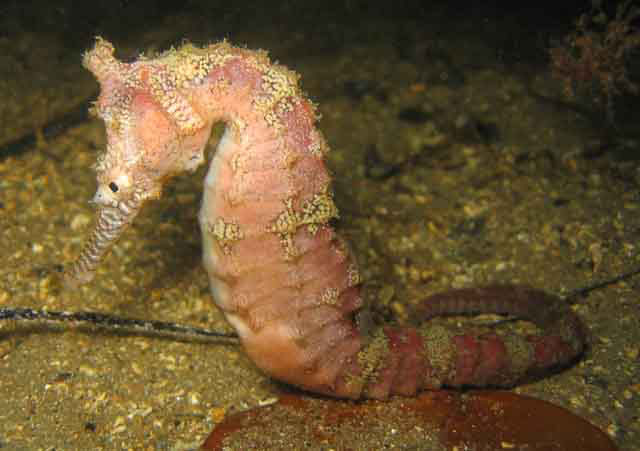| Syngnathidae (Pipefishes and seahorses), subfamily: Syngnathinae |
| 20 cm OT (male/unsexed) |
|
demersal; brackish; marine; depth range 0 - 25 m, non-migratory |
| Eastern Indian Ocean: southwest Australia. |
|
Dorsal spines (total): 0-0; Dorsal soft rays (total): 16-20. Description: (based on 23 specimens): Adult height: 13.0-20.0cm. Rings: 11+34 (33-36). Snout length: 2.1 (1.9-2.3) in head length. Dorsal fin rays: 18 (16-20) covering 2+1 rings. Pectoral fin rays: 17 (16-18). Coronet: high to very high, with an expanded rounded top (larger and more fluted in females, smaller and more rounded in males). Spines: low, rounded bumps only. Other distinctive characters: very thick rings; narrow body; usually double rounded cheek spines; long snout (about 1/2 head length); prominent rounded eye spine. Color pattern: usually pale with net-like pattern of reticulating brown lines over body and tail; may be yellow, orange, black, purple, white, cream or pink; brown ring around spines; striped snout; dark vertical line edging either side of dorsal surface of trunk. |
| Found on edge of rocky areas, muddy bottom and areas of high sediment load; jetty piles and moorings; often associated with sponges or sea squirts or attached to man-made objects; moves to deeper waters in winter. Ovoviviparous (Ref. 205). The male carries the eggs in a brood pouch which is found under the tail (Ref. 205). This species manifested evidence of genetically monogamous character in seahorses (Ref. 59213). Site fidelity is observed during breeding season (Ref. 59213). Length type refers to height (= TL - head length) (Ref. 30915). Minimum depth reported taken from Ref. 128812. |
|
Data deficient (DD); Date assessed: 25 August 2016 Ref. (130435)
|
| harmless |
Source and more info: www.fishbase.org. For personal, classroom, and other internal use only. Not for publication.

